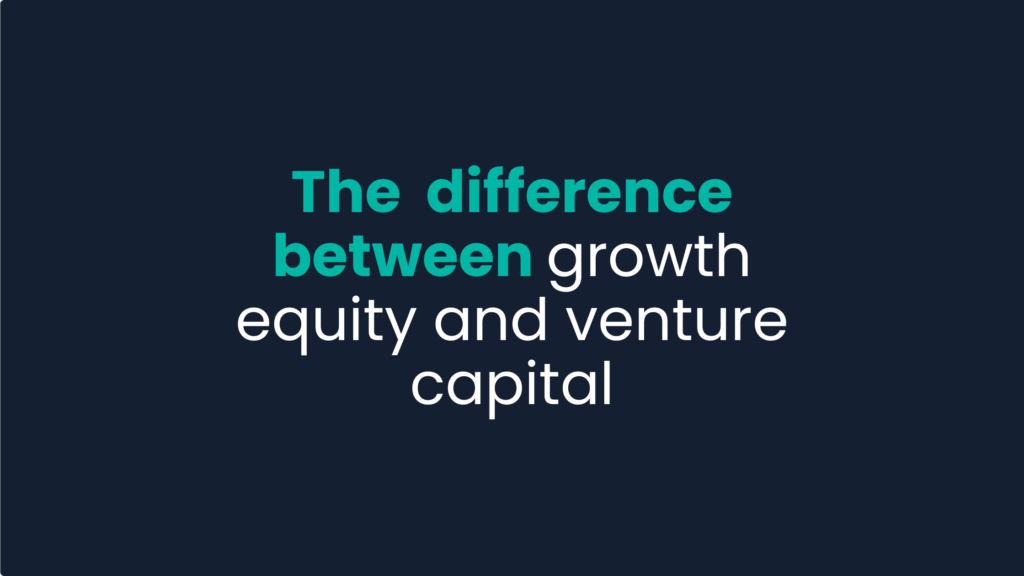One of the most common misunderstandings for software founders seeking funding is the type of investor to raise capital from. Many know about venture capital, but not many know about growth equity. Should they consider it?
To be clear, some companies know their identity from the start.
On one side, there are software companies built for venture capital. These are often founded by ambitious people with experience working at VC-backed businesses. They aim to raise multiple rounds of capital and eventually go public.
On the other side are companies that have never considered venture capital. These software businesses were founded by one or two people solving a problem for a small number of customers. The company takes years (or decades) to grow, but once it’s there, the founders and employees own the whole thing. The end game is usually selling the company to private equity.
But what about in the middle? What about companies that aren’t on the venture path but don’t want to give up control?
This is where growth equity comes in.
Growth equity is a form of financing that looks sort of like private equity and sort of like venture capital. It’s like venture capital because growth equity investors typically take a minority stake (10-40%). But it looks like private equity because they invest in profitable, mid-growth, often years-in-the-making companies. A few examples of growth equity investors are JMI Equity, Spectrum Equity, and Level Equity, though there are literally hundreds of growth equity funds.
Even though they are both minority investors, the distinctions between growth equity and venture capital can be fuzzy.
Part of this is definitional. A venture capitalist might tell you they are giving you “growth capital”, and a growth equity investor might call themselves a “software investor”. Neither of these things is wrong, per se.
Another part of the confusion is how they act. Sometimes growth equity investors will invest in companies that have raised lots of money before. Or they invest in companies that are on track to become a billion dollar company. Even worse, sometimes a brand name (like Vista Equity Partners, or Insight Partners) might have multiple funds with different strategies or sizes. Or a single fund might have a lot of flexibility in the types of investments they make.
The distinction also isn’t simply “venture capital = big” and “growth equity = small”. A number of extremely successful companies bootstrapped for years before taking growth equity. Here are just a few examples:
- SurveyMonkey (acquired for $1.5b) operated for 10 years before they took outside capital.
- Paylocity (~$8b market cap) operated for 11 years before securing outside capital.
- Workfront (acquired for $1.5b) operated for 6 years before taking capital.
- Ellucian (acquired for $3.5b) operated for 16 years before raising capital, and another 21 years before another major liquidity event.
- TrustWave (acquired for $850m) operated for 9 years before its first institutional round.
- HVR Software operated for 7 years before securing institutional capital. They sold for £700m two years later.
If you’re confused, you’re not alone. This whole thing is kind of like asking if Lightning McQueen should buy life insurance or car insurance.
So why does this matter? Because taking the wrong capital can really screw up your business, while taking the right capital can really accelerate it.
Taking venture capital can often be the wrong move. Venture capitalists make their returns based on a power law. Most of their investments go to zero, but their winners are BIG winners and carry the rest of the portfolio. This means if they invest in your company, they won’t be thrilled about getting 1-3x return. It doesn’t make sense for their portfolio. They need 100-1000x.
Growth equity is different. In their portfolio, they don’t want any of their companies to fail. They aim to find companies with a reasonable chance to return 3-5x in a few years (with a small possibility of a much higher outcome).
Growth equity can earn this return because of the companies they focus on. They want to start with a growing, profitable software company, inject capital and expertise, and take it to new heights. They prefer businesses that have been operating for at least a few years.
Here’s a typical growth equity profile: a company started in 2013 sells software to event management departments of large enterprises. The software manages user group events and company offsites, building and tracking attendee lists, pre-event communication, event logistics, mobile app for speaker lists, and ticket payments. It’s doing $15m in annual recurring revenue (ARR) and growing 35% per year. It’s profitable. The only outside capital they’ve raised was $1.5m from the founders.
Growth equity would be a perfect fit here. They’d like this business for the following reasons:
- It’s a software business with recurring revenue and high gross margins.
- The company isn’t too small ($15m in ARR).
- It’s in a large market with plenty of room to expand.
- The company is profitable.
- The company is growing at 35% per year.
- The CEO and other key executives are capable and excited to continue running the business.
- The biggest bottleneck for further growth is A) capital, B) operating expertise, C) board member-level strategic insight, D) customer introductions, or E) a combination of the above.
A growth equity investor might invest $20m in this company, with half sold to existing shareholders to take chips off the table as secondary and the other half added to the balance sheet to grow the company. The fund might now own 25% and have 1-3 board seats. The goal is to grow the business to, say $60m in ARR and sell it to a private equity fund in a few years.
Growth equity has been quite profitable, and the number of funds has recently increased. This also means the types of companies eligible for growth equity have expanded.
Previously, a company needed at least $10m in ARR to catch the interest of growth equity investors. But now, I know several funds that will invest in companies as small as $3m in ARR and as large as several hundred in ARR. They’ve expanded sector focus, too. It’s not just software (though that is the most popular), but healthcare, tech-enabled business services and other high-growth categories.
If your business resembles our example, growth equity might just be the right option for you.

